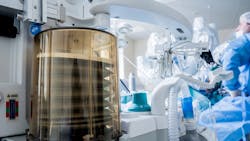Breathing Life into Obsolete Medical-Device Designs
This article is part of TechXchange: Chip Shortages and Counterfeits
What you’ll learn:
- Learn how medical-device manufacturers can mitigate the long-term risk of semiconductor component obsolescence.
- Learn how the current supply-chain disruptions in the market caused by the COVID-19 pandemic, and other factors can be managed by partnering with an authorized distributor or licensed semiconductor manufacturer to procure risk-free long-term supply.
- Learn how companies in the medical sector can plan ahead to alleviate the costs and risks of product redesign, requalification, and recertification.
Biomedical devices are categorized in terms of risk to the patient: Class I devices with low/moderate risk to health; Class II intermediate risk equipment such as Ultra/CT scanners; and Class III/IV devices critical to sustaining life such as dialysis equipment and pacemakers.
As the risk rises for patients, so do the certification costs. Original designs need to be maintained “as-is” for as long as possible. Semiconductor obsolescence presents a serious challenge to the support of biomedical products with long in-service lives and committed maintenance periods.
It’s not uncommon for large medical systems to have a concept-to-end-of-life lifecycle of 20 years, including in-service support. By contrast, semiconductor lifecycles continue to shorten, especially those of the key processor/FPGA/memory components. It’s inevitable that a supply gap of some kind will need to be bridged.
Mitigating the Long-Term Risk
Component obsolescence might be undesirable, but it’s generally manageable—at a cost. Typically, end users commit to a last-time-buy of finished components and the safe long-term storage of the semiconductors, often through a third party because the storage and handling of ICs require special conditions. While this solution ties up cash in long-term component and storage costs, at least precious design and qualification resources are spared. Where future demand exactly matches last-time-buy supply, this is a perfectly adequate solution.
However, as the COVID-19 pandemic took hold, there was a sudden and unpredicted demand for ventilators. Component stocks at the main-line distributors were quickly consumed, and when the semiconductor suppliers themselves were unable to increase capacity, a critical supply gap soon developed.
During this time, approving alternative IC sources, or a full product redesign, wasn’t possible given the re-qualification timescales. This is especially true where component obsolescence also impacted software performance.
To bridge the supply-chain gap, ventilator manufacturers looked to breathe life into discontinued systems to fulfill this critical need. By using previously approved ICs, such as older die iterations, or by resurrecting older system designs, production was able to continue.
Authorized distributors, such as Rochester Electronics, have become trusted sources for discontinued semiconductors after end-of-life. Stock remains fully authorized, stored under AS6496 conditions, providing a risk-free source of supply.
Furthermore, partnering with a licensed semiconductor manufacturer can mitigate the risks of component end-of-life. A licensed manufacturer can produce devices no longer supplied by the original component manufacturer (OCM).
When a component is discontinued, the remaining tested wafer and die, the assembly processes, and the original test IP, are transferred to the licensed manufacturer by the OCM. This means that previously discontinued components are still available newly manufactured, and 100% in compliance with the original specifications. No additional qualification is required or software changes.
Supply issues over the last 12 months have undermined the normal delivery certainties. COVID-19-related manufacturing, shipping disruptions, and even unexpected natural disasters have led to supply-chain uncertainty and lengthening lead times. Component discontinuation notices have risen by 15% over the same period as third-party fab priorities have changed and the industry refocuses its fab investments to address a lower-powered battery-dominated landscape.
It’s essential for companies in the medical sector to:
- Insist on the maximum number of cross-references from the design phase onward.
- Plan component purchases further in advance.
- Consider carrying more inventory of critical semiconductors.
- Monitor lead times and component lifecycles regularly.
- Understand supply risks and prepare dual/multi-sourcing strategies to cover all eventualities.
- Partner with an authorized distributor and/or licensed manufacturer to help manage and maintain consistent longevity of supply.
Read more articles in TechXchange: Chip Shortages and Counterfeits
About the Author
Ken Greenwood
Technical Sales Manager EMEA, Rochester Electronics
Ken Greenwood is the Technical Sales Manager EMEA for Rochester Electronics. He has over 30 years of experience in the electronics industry working in strategic sourcing roles at Nortel World-wide and Matra Comms France before moving into Sales and Field Applications Management roles in the Connectors and RF/Microwave markets.
In his current role, Ken provides a vital interface between Rochester’s Supply partners and the market: tracking and highlighting lead-times and supply issues, and matching market needs with Rochester’s instant stock or our long-term manufacturing abilities.
